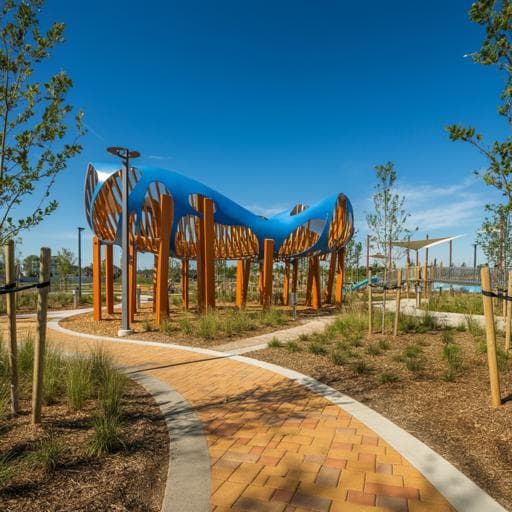
Social Work
Towards social sustainability in urban communities: exploring how community parks influence residents' social interaction during the COVID-19 pandemic
C. Yang, S. Shi, et al.
This research explores how community parks foster social interaction in Sydney's master-planned communities during the COVID-19 pandemic. Through interviews with residents, the study highlights the vital role of quality park spaces, pedestrian integration, and connectivity in enhancing social well-being and sustainability. Conducted by Chunyan Yang, Song Shi, Goran Runeson, and Duanfang Lu, this study reveals insights crucial for urban planning.
~3 min • Beginner • English
Introduction
The COVID-19 pandemic triggered widespread lockdowns and social distancing, intensifying social isolation and mental health challenges. Concurrently, park visits—especially to community parks—increased, highlighting their importance to residents’ wellbeing and social cohesion. Despite recognition of public open spaces as facilitators of social activity, limited research examines how community parks affect social interaction during health crises, particularly within Australian master-planned communities (MPCs). Key gaps include: limited understanding of specific green space features that support neighbourhood social interaction; scarce evidence on park effects on social wellbeing during COVID-19; little knowledge of daily life and social activities in Australian MPCs; and a dearth of qualitative, in-situ evidence collected during the pandemic. This study addresses these gaps by investigating how community parks influence residents’ social interactions in two inner-urban Sydney MPCs—Breakfast Point (BP) and Liberty Grove (LG)—during COVID-19. The research question is: How do community parks influence residents' social interactions in master-planned communities in Sydney? The study advances understanding of human–environment relationships in MPCs and provides qualitative evidence of pandemic-period park use, social activities, and behavioural patterns.
Literature Review
The study is grounded in social ties theory and social network theory, integrated with urban design perspectives on public space. Social ties theory (Granovetter, 1973) distinguishes strong, weak, and absent ties, with weak ties often crucial for neighbourhood social wellbeing. Absent ties (non-verbal encounters, such as seeing others) can also benefit wellbeing, especially during isolation. Social network theory (Berkman et al., 2000) frames how social structures affect health through support, influence, engagement, and access to resources; this study extends the model by incorporating 'place' as a key dimension. Empirical work links neighbourhood social interaction to personal, social, and built environment factors, with public open space quality and accessibility prominent. Prior studies and frameworks (e.g., UN-Habitat, Australian Classification Framework for Public Open Space) identify park space quality dimensions—recreation (e.g., BBQ/picnic, seating, shade), sport, and nature (green coverage, biodiversity, water features)—as relevant to social wellbeing. Pedestrian integration (accessibility, size, distribution; small and frequent parks; interconnected networks) and connectivity to surroundings also shape social interaction and can mitigate socio-spatial segregation—an issue salient in Australian MPCs. During COVID-19, global evidence shows increased importance of local parks for health and social needs, shifting behaviour toward nearby green spaces, elevated demand for outdoor social activity, and heightened attention to quality, access, and connectivity—alongside exacerbated inequalities in park access and use for groups such as elderly, children, youth, and women. MPCs in Australia aim to foster community via physical and social infrastructure but vary by enclosure and connectivity; most research has focused on outer-suburban estates, leaving inner-urban MPCs under-studied. This study focuses on inner-urban MPCs and examines how park factors translate into social interactions (strong, weak, absent ties).
Methodology
Design: Qualitative case study. Two inner-west Sydney MPCs—Breakfast Point (open form) and Liberty Grove (symbolically enclosed/gated)—were selected for similarities in location, scale (>500 properties), and high-quality parks, and for contrasting built forms and connectivity characteristics. Data collection: Sixteen semi-structured Zoom interviews conducted in 2022 during the COVID-19 pandemic (8 BP, 8 LG). Sampling: purposive and snowball sampling to capture diversity across age, gender, marital status, employment, education, dwelling type, family composition, and length of residency. Recruitment via closed neighbourhood Facebook groups and follow-up from a related 2021 survey (UTS HREC ETH20-5480). E-consent via Qualtrics; interviews recorded with privacy safeguards following Salmons’ E-Interview Research Framework. Sample profile: Majority aged 20–59; three participants 60+; education levels included high school, diploma, bachelor (n=7), master (n=3), doctoral (n=1); employment varied (full-time n=7, part-time n=5, others n=3); length of residency included 5–10 years (n=7) and >10 years (n=4). Data analysis: Audio transcribed verbatim. Thematic analysis using NVivo 12 following Braun and Clarke (2006): cleaning, transcription, familiarization, inductive coding, clustering, theme development and refinement, interpretation. A coding framework was developed, yielding three main themes and subthemes. Data saturation reached after 16 interviews. Ethics: Approved by the Human Research Ethics Committee of the University of Technology Sydney (ETH21-6087; amendment ETH21-6736 for online methods). Informed consent obtained; anonymity preserved. Participants received AUD 30 gift cards.
Key Findings
- Three main themes link park use to social interaction (SI) among MPC residents: (1) Quality of park spaces; (2) Parks’ pedestrian integration; (3) Parks’ pedestrian connectivity with surroundings. SI manifests as strong ties, weak ties, and absent ties. Sample size: n=16 (8 BP, 8 LG).
- Quality of park spaces (five subthemes):
• Rest spaces: Most frequently cited reason for park visits; facilitate weak ties (greetings, brief chats, observing others), strong ties (meeting friends/family), and group activities. Needs identified: more seating and shade/shelter; uncovered seating areas limit use in hot summers.
• BBQ/picnic spaces: Support strong ties and community participation (family gatherings, parties). Reported shortages of BBQs and picnic tables (competition for limited facilities; need to arrive early to secure spots). Some noise concerns near residences.
• Children’s playgrounds: Crucial for families; promote weak ties among parents (short conversations) and strong ties via playdates and group events (e.g., birthday parties). Provide social support during the pandemic.
• Sports facilities: Enable strong ties (playing tennis/football with neighbours), group activities (yoga, tai chi, competitions), and weak/absent ties (brief chats, watching games). Reported inadequacy and age-appropriateness gaps; demand for multi-use courts and youth facilities.
• Nature amenities: Trails, green areas, waterside spaces encourage walking and casual encounters (weak/absent ties), and strong ties (walking with friends). Especially valuable for apartment residents and vulnerable groups.
- Parks’ pedestrian integration:
• Interconnected park network and a clear, walkable central park increase activity and social participation (e.g., festivals, events).
• Well-dispersed small parks between buildings enhance accessibility, particularly for apartment residents, and promote frequent casual interactions.
- Parks’ pedestrian connectivity with surroundings:
• BP (open MPC) exhibits strong pedestrian connections to surrounding parks, enabling seamless activity spillover (BBQs, walks) and maintaining socialization outside the estate.
• LG (symbolically gated) requires crossing traffic roads to reach external parks, raising safety concerns and reducing outside-park social interaction; most social encounters occur within LG.
- COVID-19 impacts:
• Parks remained important for social wellbeing; residents used BBQ/picnic areas to maintain strong-tie interactions in compliant ways.
• Increased reliance on nature amenities for stress relief and weak/absent ties during isolation (e.g., greetings while walking). Especially beneficial for elderly, children, pregnant women, and those recovering from COVID-19.
• Heightened visibility of facility inadequacies (BBQs, sports, playgrounds) amid increased demand.
- Quantitative descriptors: 16 interviews; equal case distribution (8/8). Demographic diversity across age, education, employment, and residency length supported thematic saturation.
Discussion
Findings directly address the research question by identifying which park characteristics shape residents’ social interactions in MPCs and how these interactions (strong, weak, absent ties) are enabled through specific spatial and amenity features. Rest spaces are central to both casual and deeper social connections, aligning with social ties theory (weak ties’ value) and extending social network theory by highlighting place-based mechanisms. Recreation (BBQ/picnic), sports, playgrounds, and nature amenities support different social pathways—facilitating both bonding (strong ties) and bridging (weak ties) interactions. Pedestrian integration through an interconnected network and well-dispersed small parks increases accessibility and encounter frequency, fostering casual interactions and community participation. Connectivity with surrounding areas further expands activity options and social opportunities; open, well-connected MPCs (e.g., BP) demonstrate stronger external socialization than symbolically gated settings (e.g., LG), suggesting design and governance implications for mitigating socio-spatial segregation. During COVID-19, local parks became essential for preserving social wellbeing, reinforcing the importance of nearby green infrastructure, distributed small parks, and walkable networks. These results substantiate and nuance prior literature on public space, new urbanism, and socio-ecological models, emphasizing the practical importance of shaded seating, age-appropriate sports/play facilities, and external connectivity to support diverse social needs.
Conclusion
Community parks in Australian MPCs significantly promote social interaction, particularly during the COVID-19 pandemic. Key contributions: (1) Empirical identification of park-use factors—quality of spaces (rest, BBQ/picnic, playgrounds, sports, nature), pedestrian integration (interconnected networks, well-dispersed small parks), and connectivity with surroundings—that translate into strong, weak, and absent ties. (2) Theoretical validation and extension of Granovetter’s weak ties and Berkman’s social network frameworks by incorporating place-based mechanisms; integration with new urbanism’s emphasis on public space. (3) Practical insights for planning resilient, socially sustainable MPCs, challenging assumptions of isolation by demonstrating benefits of external connectivity. Recommended strategies: expand and improve park amenities (shaded seating, age-diverse sports and play, wider walking paths); develop more small, well-dispersed parks integrated into cohesive pedestrian networks; and enhance openness and pedestrian connectivity to surrounding areas. Future research should examine interrelations among tie types and test generalizability across varied residential contexts and cities.
Limitations
- The study did not examine dynamic interrelationships among strong, weak, and absent ties; future work should explore how these tie types interact and evolve.
- Limited to two inner-urban MPC case studies in Sydney with 16 interviews; findings are transferable to similar contexts but not broadly generalizable to other residential settings or cities without further research.
Related Publications
Explore these studies to deepen your understanding of the subject.







